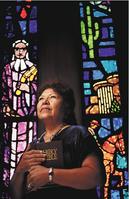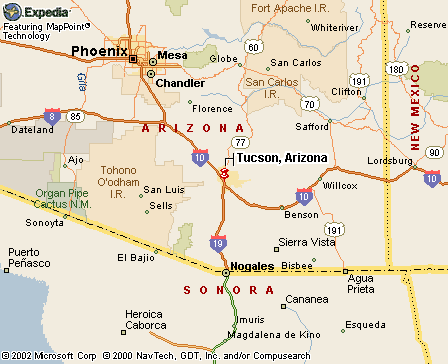|
Navajo
still clings to lessons learned on the reservation
 There
are times when Shirley Montoya needs to see a medicine woman. There
are times when Shirley Montoya needs to see a medicine woman.
There are times when she ceremonially burns sweet grass to help
purify the mind and prepare for meditation.
There are times, when she's in a new place, that she gets to know
the spirits of the current residents, including the trees and the
cactus, so she doesn't feel like an outsider.
Considering Montoya is a Navajo woman, none of these cultural practices
are unusual. They just aren't the typical activities for your run-of-the-mill
ordained Christian minister.
Montoya, 58, came to Tucson in July to take a post as associate
pastor for Christ Church United Methodist, 655 N. Craycroft Road.
She's a long way from her home on the Navajo reservation on the
Arizona-New Mexico border - and not just in miles.
When she decided to pursue ministry, going through a two-year process
to become ordained, she said leaders in the the New Mexico hierarchy
of the church refused to ordain her unless she gave up her Navajo
ways, like the eagle fan used to bless people and the sage burned
to start ceremonies.
She said her response was, "God made you a white person. God
made me an Indian. The culture isn't bad. It was God who kept us
going all these years."
She couldn't divorce herself from her roots. "How do you do
away with yourself? How do you hate yourself?" she mused.
"It took me two years on my knees to come to the conclusion
that I'm a Navajo woman and I just have to respect that."
So she moved to Arizona, taking a job as dean of academic affairs
at Cook College & Theological School in Tempe, an ecumenical
Christian institution of higher education serving Native Americans.
She decided to start the process to become a minister all over again.
She was ordained in 1996.
Her path is something of a miracle in itself. The United Methodist
Church has a small presence on the reservation - it doesn't even
have a church on the Arizona side. She grew up within traditional
Navajo religion, based on the tribe's creation stories, the theme
that people walk in beauty, that all things are interconnected and
that the body is sacred.
Her introduction to Methodist beliefs came in 1979, when she was
invited to a Methodist revival. She jokes that she went because
there wasn't much else to do on the reservation then. An uncle -
related by clan, as opposed to blood - was preaching, and she was
grateful to hear someone from a Christian background also embracing
Navajo culture.
She still believes there's no reason her culture and her religion
need to be mutually exclusive. Her message to her congregation at
the Christmas Eve Mass pointed out the parallels between them.
The Navajo believe that breath is a holy wind, the spiritual part
of a being. That's something like the Holy Spirit, she said.
The Navajo ceremonies teach about wholeness and wellness - that
the body, spirit and mind must all be in tune. The apostle Paul,
in Romans, talks about his struggle between his mind and his will.
"We all wrestle with that," she said.
Her people are wrestling in other ways, she said. Diabetes is rampant.
The old ways are being lost. Few know how to make cornmeal mush
or dry meat or sweeten cake with wheat germ.
At a puberty ceremony for her granddaughter this summer, her daughter-in-law
showed up in cut-off shorts to help prepare the cornmeal. One of
the matriarchs sent her home for more appropriate dress. But her
daughter-in-law's mother had never told her about the proper way.
So it was with mixed feelings that she came to Tucson because she
knows how much she is needed back home. Her husband, her three sons
and her grandchildren are all in Ship Rock, and it's an eight-hour
drive to see them.
She has a "First Laugh" picture of her sixth grandchild,
Koleton, on her desk. The first time a baby laughs, the family must
hold a dinner for the community to ensure the baby grows up generous
and happy. His dinner was in October.
When she went home over the holidays, it hurt her to feel how cold
her husband's home felt. He doesn't entirely understand her path.
His own father was a medicine man. But he does understand "that
when you're called by the Creator, it's not something you can just
put aside."
She needs to learn about how to run a larger church. And she thinks
her congregation, where she preaches at least once a month, can
learn from her as well, because she offers a different perspective.
People cut down Christmas trees without much thought to their life
and then throw them away. Back home, she said, the Navajo way is
to offer corn pollen to ask for forgiveness, and then use every
part of the tree. Needles are burned at ceremonies. The wood facilitates
cooking.
She'll be bringing Native American Sunday, including Yaqui deer
dances and songs, to her church on Feb. 15.
In the meantime, she draws strength from a story about her mother's
childhood, when her mother got lost in a snowstorm while herding
sheep on the Mesa Verde in Colorado. As her frightened mother huddled
against a rock, she heard footsteps. Her father had ridden his horse
all the way from Ship Rock, following a feeling that his daughter
was in trouble.
"The lesson was that the Creator always finds us. No matter
where we are, or where we come from, we won't stay lost."
So even though she's in Tucson now, maybe, someday, she'll be called
back home.
* Contact reporter Rhonda Bodfield Bloom at 807-8031 or rhondab@azstarnet.com
|


 There
are times when Shirley Montoya needs to see a medicine woman.
There
are times when Shirley Montoya needs to see a medicine woman. 